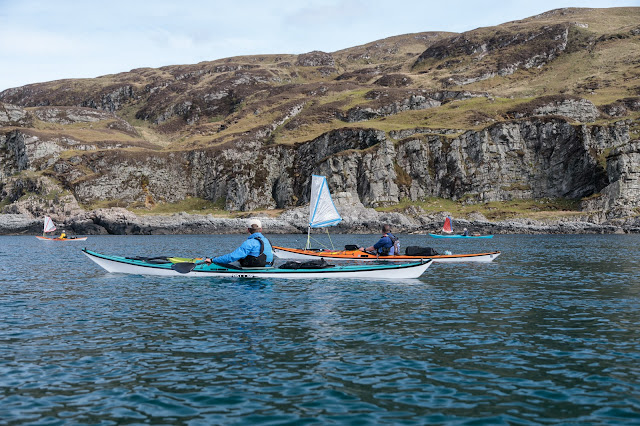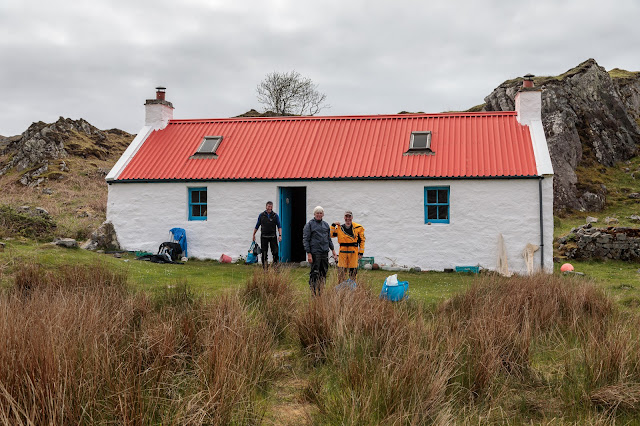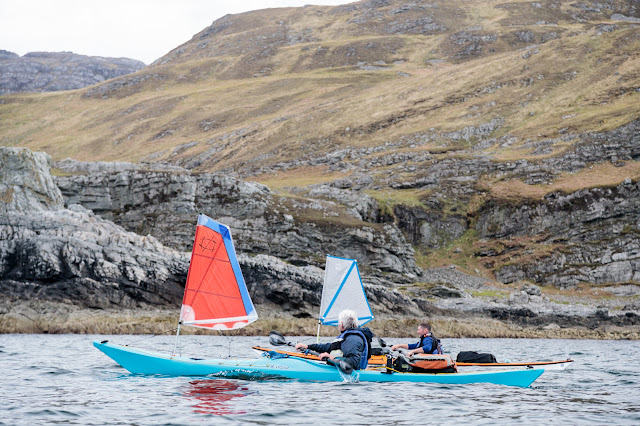As we were finishing second breakfast, the chilly silence of Corpach Bay was broken by the rumble of engines. The SC Nordic, a Danish pallet carrier of 4,786 gross tonnage, was making her way NE between Colonsay and Jura towards the Sound of Mull. She was enroute from Greenock on the Clyde to Skogn in Trondheimsfjorden, Norway. Soon she was out of earshot and silence again fell over the bay of the dead (Corpach Bay).
Once on the water again, too much north in the wind kept our sails furled but steady progress...
...saw the brooding bulk of Scarba increasingly dominate our view ahead.
Scarba marks the northern side of the fearsome Gulf of Corryvreckan and its steep slopes plunging into the rushing tides add to the intimidating nature of the place...but more of that later.
We were able to launch the sails again as the onshore breeze backed to a tight reach. Above the rough hills our eyes were drawn to...
...the magnificent sight of a pair of...
...white tailed sea eagles soaring on the same onshore wind (which we were paddle sailing in) creating an up draught above the slope.
This one either had a white tag on its wing or was missing some feathers. Maurice was amazed. He had gone from never having seen a sea eagle to seeing 4 within 24 hours. It did occur to me that this might be the same pair that we had seen the previous day, some 25km to the west on the east coast of Colonsay. However, they are lazy big birds and once they have a mate and territory they tend not to stray far. On average a sea eagle's territory is about 8km in diameter.
There are very few places to land on this rough coast pathless which is the domain...
...of these nimble goats.
Neither Maurice nor Sam had been through the Corryvreckan before and they fell behind in some deep discussion about what to expect.
Neither of them seemed convinced....
...by my reassurances that it would be flat as a pancake, especially as we drew ever nearer to the Gulf. Perhaps this was because the previous evening, Ian and I had given a dramatic account of our last trip through the Corryvreckan. This had involved breaking standing waves and moving backwards. This was despite paddling forward at full pelt, the tide had turned against us and threatened to carry us back the way we had just come.
On this trip, the west going spring flood was still in full flow at 8 knots and as we wanted to traverse the Gulf to the east it was time for a sharp...
...exit to the right, where we entered
Glengarrisdale Bay where the eponymous...
...red roofed bothy lay at the back of the bay. It would make an ideal shelter from the cold wind for our three hour wait for the tide to turn.
So we landed on the sands of the bay and...
...warmed up by carrying the boats well up the beach...
...so that we would be sure the tide would not carry the boats away during an extended Glengarrisdale luncheon.






















































